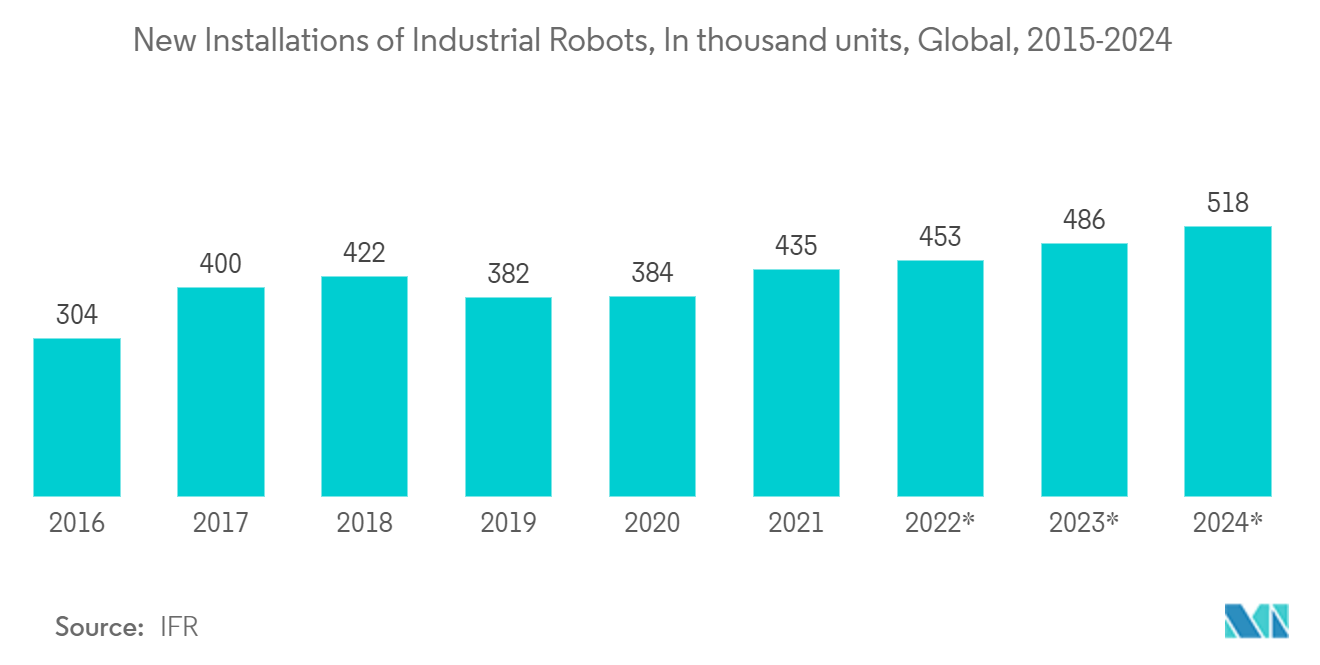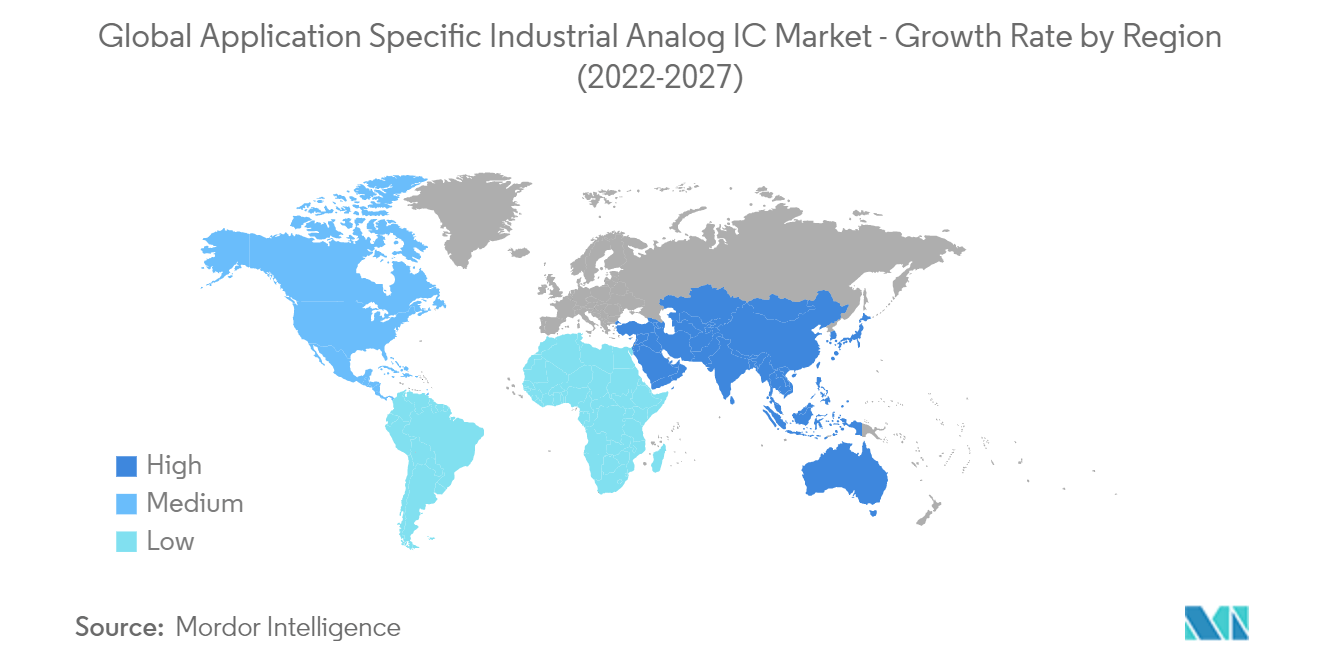Market Trends of Global Application Specific Industrial Analog IC Industry
This section covers the major market trends shaping the Application Specific Industrial Analog IC Market according to our research experts:
Advancements in Internet of Things and Artificial Intelligence is Expected to Drive the Market's Growth
- The growing adoption of IoT technology in several end-user sectors, such as manufacturing, energy, utilities, etc., is driving the need for application-specific industrial analog ICs. With the traditional manufacturing sector amid a digital transformation, IoT is fueling the next industrial revolution of intelligent connectivity. IoT and AI are at the center of new technological approaches for the development, production, and management of the entire logistics chain, otherwise known as smart factory automation. Massive shifts in manufacturing due to Industry 4.0 and acceptance of IoT require enterprises to adopt agile, smarter, and innovative ways to advance production with technologies that complement and augment human labor with robotics and reduce industrial accidents caused by a process failure.
- The growing trend of adopting connected devices in the industrial sectors is positively influencing the studied market. According to Ericsson, the number of Massive IoT connections is expected to have doubled, reaching close to 200 million connections. In the industrial sector, the adoption has penetrated across industries. For instance, according to Aruba Networks, IoT devices have become increasingly pervasive, with 85% of businesses expected to have implemented the technology. Moreover, the benefits offered by IoT in reducing cost, predictive maintenance, and data analytics are driving the adoption rates in the industrial segment. 5G is also boosting the scope of IoT in the sector, as the technology is most relevant for connecting industrial robots with various degrees of mobility. These robots have IoT sensors for situational awareness and autonomous functioning.
- Further, Germany is expected to be at the forefront of the adoption of IoT solutions compared to any other major country across the world, and this is augmented by the proliferation of the technology in industrial applications. According to the Microsoft study, in 2020, Germany had the highest percentage of adopters, which stood at 94% during the year, followed by France, the US, and China. Also, according to a Bitkom study on the digitization of the German industry, which surveyed 551 industrial companies with 100 or more employees between February and March 2021, 95 % of German companies said that digitization became more critical to their business in the aftermath of the COVID-19 pandemic. The German ICT market plays an essential role in consolidating the country's industrial production strength. The German enterprises have been quick to adopt IoT technologies, with the manufacturing and automotive industries taking the lead, which serves for the expansion of the market for application-specific industrial analog ICs.
- Moreover, Asia-Pacific has been an early adopter of technological advancements, such as AI and IoT. For instance, according to Huaon.com, in 2020, the size of the Chinese internet of things (IoT) market amounted to almost CNY 1.7 trillion, a 12% increase compared to the previous year. It is estimated to increase to CNY 2.8 trillion in 2025. Also, according to the Infocomm media development authority, the Singapore IoT market size is estimated to be USD 1.1 billion in 2022. Some of the critical factors for the widespread adoption include the Smart Nation initiatives driven by the Government and the current Industry 4.0 drive in the Manufacturing and Logistics sectors. Also, favorable infrastructures such as high fiber connectivity, data centers, submarine cables, and investments in low power networks and 5G networks by operators are likely to drive IoT adoption further.
- The market in these developing economies poses a key advantage in implementing industrial automation since it is not tormented with rebuilding legacy automation systems and machine investments. These factors significantly contribute to the proliferation of the application-specific industrial analog IC market.

Asia Pacific is Expected to be the Fastest Growing Market
- Asia-Pacific is anticipated to record the highest market growth rate during the forecast period, pertaining to the noteworthy installation of industrial robots in several countries including China, Japan, India, South Korea, and Taiwan. China is dominating the regional adoption rate of sensors for the robotic applications, due to the massive deployment in the country's automotive and semiconductor manufacturing industries. China is a manufacturing giant and has a strong consumer base for electronics and related components which is a major factor contributing to the application specific industrial analog IC market. The country also has significant manufacturing base in automotive, electronics, aerospace and defense, food and beverage and other industries which is analyzed to further boost the market growth rate.
- Additioally, the growing government aid in the improvement of the advanced manufacturing sector is set to positively impact on the market growth rate. The government of China launched 'Made in China 2025', a state-led industrial policy that seeks to make China dominant in global high-tech manufacturing.
- Also, as per the 13th Five-year Plan of Smart Manufacturing, China aims to mainstream its intelligent manufacturing system and industry transformation by 2025. The plan, released by the Ministry of Industry and Information Technology (MIIT) and seven other departments, came as countries like the United States, Germany, and Japan push to increase intelligent manufacturing. According to the plan, more than 70% of large-scale Chinese enterprises would be digitalized by 2025, and over demonstration manufacturing facilities would be built across the country.
- Moreover, in May 2022, Japan External Trade Organisation (Jetro) announced that it is collaborating with government agencies and Japanese companies to accelerate the adoption of Japanese Industry 4.0 smart manufacturing technologies among Malaysian small and medium enterprises (SMEs) as part of the Look East Policy (LEP) cooperation. Jetro has been collaborating with International Trade and Industry Ministry, Malaysian Investment Development Authority (Mida), and Sirim Bhd to aid Malaysian SMEs in adopting smart manufacturing practices since 2019. Such developments would offer lucrative opportunities for the prolification of the application specific industrial analog IC market in the region.
- As automotive, electronics, and manufacturing sectors are also developing at a significant growth rate in other economies such as South Korea, Japan and India, there is massive potential for growth in this regional market. An increase in infrastructure investment by the government, coupled with the 'Make in India' initiative is expected to drive the demand for various sensors used in them, thereby driving the demand for the studied market. The Government of India aims to increase the manufacturing sector's share of the gross domestic product (GDP) to 25% by 2022, from 17% in 2018. Thus, manufacturers are expected to incorporate Industry 4.0 and other digital technologies to achieve this target.

